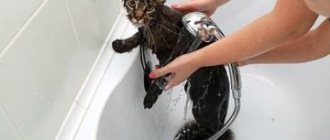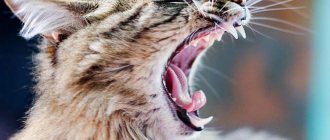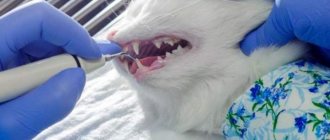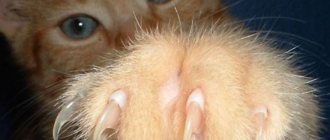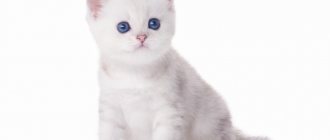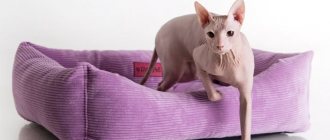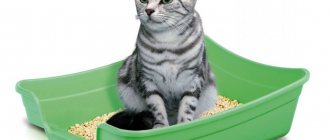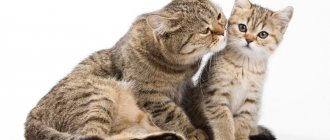Why is it necessary to brush cats' teeth?
By nature, a cat is a predator. Under natural conditions, an animal cleanses its teeth spontaneously while eating prey (it eats raw meat and gnaws bones). Specialized food is, to some extent, an imitation of wild food.
If your pet eats only soft food, the oral cavity must be cleaned.
Of course, there is no need to brush your animal's teeth twice daily. It will be enough for him to carry out this procedure a couple of times a week for preventive purposes. If you regularly clean your mouth of food debris, you can prevent the development of stomatitis, gingivitis, caries, tartar and periodontal disease. However, consistency is important in this matter.
Teaching a cat to brush its teeth
The kitten needs to be accustomed to the presence of the owner's finger in its mouth. For starters, you can lubricate it with something sweet. This will help the baby get used to the subsequent procedure.
To clean the oral cavity of a small animal, you can initially use special gels with disinfectant properties to freshen breath. Over time, you need to carry out the procedure using a toothbrush and toothpaste.
In order for the cat to get used to the taste of the new product, you need to lightly lubricate your pet’s nose with it.
An adult pet should also be accustomed to brushing its teeth, although this will require a long time, maximum patience and perseverance. Since the pet has already grown up, it will be more difficult for him to get used to some actions or to the presence of the owner’s finger in his mouth.
Preparing the animal
Training a small animal is definitely easier than training an adult cat. In this regard, once the kitten is born, you should regularly set aside time for brushing your teeth.
Accustoming an adult pet to cleansing the mouth should be done gradually and correctly:
- You need to buy special hygiene products for the animal at the veterinary pharmacy. Human brushes and toothpaste are not suitable for cats, as they can damage gums and tooth enamel.
- Let your pet explore new items: sniff and examine. This will help him endure further teeth cleaning without panic.
- A few days before the procedure, you need to let the animal try the paste so that it is not frightened by new sensations.
- It is better to clean the oral cavity at a time when the cat has eaten and is about to sleep. At this moment, he will be as curious as possible, which can play in favor of the owner.
- If you have several pets living in an apartment, you will need to purchase an individual brush for each one to clean their mouth.
After completing the preliminary preparation, you can proceed to cleansing the oral cavity.
Prices
| Procedure name | Price in rub. |
| Initial appointment with a therapist or surgeon | 950 |
| Repeated appointment with a therapist or surgeon (14 days after the initial appointment) | 700 |
| Sanitation of the oral cavity of dogs (ultrasonic scaling, polishing, antiseptic treatment), category 1 (less than 50% of the teeth are affected), (without the cost of anesthesia) | 3000 |
| Sanitation of the oral cavity of dogs (ultrasonic scaling, polishing, antiseptic treatment), category 2 (damage to more than 50% of the teeth) (without the cost of anesthesia) | 5000 |
| Sanitation of the oral cavity of cats (ultrasonic scaling, polishing, antiseptic treatment), (without the cost of anesthesia) | 2500 |
| Removal of a tooth: | |
| - baby tooth (except fangs) | 300 |
| – baby canine (simple extraction) | 700 |
| — baby canine with gum plastic surgery | 1200 |
| — single-root category 1 (periodontal) | 600 |
| — single-root category 2 * | 900 |
| — double-root category 1 (periodontal) | 600 |
| — two-root category 2 (with the crown divided into parts)* | 1000 |
| — three-root category 1 (periodontal) | 700 |
| — three-root category 2 (with the crown divided into parts)* | 1700 |
| — canine category 1 (periodontal) | 800 |
| — fang category 2* | 1400 |
| — canine category 3 (with oronasal fistula repair) | 2200 |
Show full list
Cleaning your pet's teeth at home
First, toothpaste and a brush are prepared, then the head and paws of the animal are securely fixed. The pet is positioned between the legs with its tail facing the owner so that he does not back away from discomfort.
Sometimes you need to swaddle a cat or ask for help so that one person can hold the animal while the other cleans the oral cavity. This method is very relevant if cleaning is carried out for the first time on an adult pet.
The brush is lubricated with toothpaste and cleansing begins: first the movement is up and down, and then left and right. Cleaning is carried out both on the outside and on the inside.
For a very timid animal, during the first procedures the brush can be replaced with a cotton swab, and then a toothbrush is gradually introduced.
To prevent the development of tartar, it is recommended to clean the mouth a couple of times a week.
If a special cat brush is not available, you can use a baby brush with soft bristles, which should be trimmed lightly.
How often should you clean
It all depends on the degree of neglect of the oral cavity. If your cat's teeth are generally good and she regularly eats solid and natural food, then brushing can be done once every week and a half.
If your pet sits on soft canned food and has an unpleasant odor coming from his mouth, then you will have to gradually accustom him to brushing once every three days. In addition, it will not be possible to remove or dissolve a thick layer of plaque or tartar on your own without damaging the enamel.
In advanced cases, contact a veterinary clinic and make an appointment for your cat to see a veterinary dentist. He will remove the plaque using an ultrasound method - this is a painless procedure that does not cause any harm. Sometimes there is a need for anesthesia if the animal is angry and will not be handled.
Did you know? Cats played a big role in the life of Napoleon Bonaparte, who was deathly afraid of them. In early childhood, he was scared by a stray cat and has avoided these animals since then. This unusual phobia became known to the English commander Admiral Nelson, who took advantage of the weakness of his enemy and released a herd of cats onto the battlefield ahead of his regiment. Napoleon gave in to the fluffy army and transferred command of the troops to his assistant, which was a big mistake, since the Battle of Waterloo was ultimately lost.
Mr. Cat recommends: An alternative to oral care
Sometimes an animal does not want to have its teeth brushed at all. It scratches, bites and refuses with all its might to open its mouth. As a compromise in this case, veterinarians suggest using alternative means. It is worth noting that the effect of such a procedure will be slightly less.
The pet store sells a special liquid gel that has a pleasant taste and aroma for the animal. Not a single animal will refuse a treat. A similar product is added to the pet’s water or food. Once in the oral cavity, the components of the drug eliminate pathogenic bacteria on the gums and help eliminate small plaque from tooth enamel.
In addition, you can buy a special healthy bone soaked in a substance that helps prevent the appearance of tartar. When an animal chews on them, teeth cleansing begins: the canines are polished under the action of a hard surface, and bacteria and plaque are destroyed with the help of active ingredients.
In addition, as an alternative, you can contact a veterinary hospital. Specialists will help clean your animal’s teeth using ultrasound.
Alternative to home cleaning
If you are not sure that you can effectively brush your cat’s teeth on your own, or your cat not at all subtly hints to you every time that she does not like the procedure, then alternative cleaning methods will come to your aid.
The easiest way is hygienic bars from zoo pharmacies made from pressed cereals, meat and reagent components for dental plaque.
The second method is liquid gels for dilution in water. They are sold in pet stores and pet pharmacies, and the principle of operation is simple. According to the instructions, a portion of the gel is diluted in a portion of water and given to the cat as a regular drink. Most often, this option is acceptable for kittens up to six months old.
Special sprays are another cleaning option, but you still have to hold the cat while applying the solution.
IMPORTANT: hard dental foods exist, but it is not recommended to make them the basis of the diet. It is best to either mix this food with the main one, or give it once on a schedule.
In extreme cases, when tartar has already formed, it is better to entrust cleaning to specialists. The veterinarian, under light anesthesia, performs ultrasonic cleaning of the cat’s teeth, after which you can return to gels and pastes at home to maintain the results.
The cost of cleaning a cat’s teeth depends on the clinic and the extent of the problem. In the regions the price is approximately 700-1500 rubles, in Moscow and St. Petersburg 2500-3500 rubles.
Tips for cleaning your cat's mouth
The best option is to teach your pet to clean the mouth from childhood. The animal will get used to it and will not hide when it sees the owner with hygiene products in his hand.
Here are some recommendations for the procedure:
- The cat must get used to the owner's hands. To do this, you can feed the kitten by hand, and in the process touch the teeth;
- After the baby gets used to it, you can start wiping the tooth enamel with wet wipes. It is recommended to give your cat a treat before and after cleaning as encouragement. As an alternative, you can purchase a vitamin stick at a pet store - it is both a treat and beneficial for the oral cavity;
- When cleaning your teeth with a brush, it should be tilted at an angle of 45 degrees, and not vertically. Cleaning is carried out with gentle up and down movements on each side;
- The duration of the first procedure should be approximately 10 seconds for each row. Subsequently, the time increases to 30 seconds;
- Cleaning the gums is prohibited, especially with a hard brush, so as not to cause injury. There may be bleeding at first, but it will stop over time.
Do not forget that in natural conditions animals do not clean their mouths, so manipulation must be carried out very carefully.
Results
Now you understand that this manipulation is not a fad, but an important procedure that can keep your pet’s teeth in perfect condition. You should not be afraid of anesthesia, since Propofol is mainly used - this is a light medication for sedation. Do not listen to incompetent people who offer cleaning in 20 minutes without anesthesia; this will be done poorly, which will lead to irreparable consequences in the future. You must understand that such cleaning should be carried out by a veterinarian, as this is not a cosmetic procedure. Don't forget, teeth are very fragile and care for them must be constant, especially in animals, as without them your cat will not be able to eat, which will lead to other terrible consequences.
How to prevent your pet's whims?
Sometimes it is impossible to hold your pet while brushing his teeth.
In this case, you can use other methods to facilitate the procedure at home:
- You should occasionally replace soft food with hard food to reduce the possibility of tartar formation on the teeth;
- at the pet store you can buy a special toy that helps cleanse tooth enamel;
- When your pet does not tolerate the paste, it is recommended to add it to dry food or to a dental toy. So it will certainly end up in the animal’s mouth;
- Today you can purchase a liquid paste to control the number of pathogens in your pet’s mouth. The product is diluted with water in a ratio of 1 teaspoon per 200 ml. But you should not use it often, as this can lead to changes in the enamel on the teeth;
- When feeding your cat natural products, you can purchase treats with nutritious fiber. This helps clean the mouth when chewing;
- To wipe your teeth, you can use a soda solution or hydrogen peroxide.
In addition to cleaning your mouth at home, do not forget about an annual examination by a dentist at a veterinary clinic.
Cleaning tooth enamel is an unpleasant procedure. If it is carried out carefully, and begins in the pet’s childhood, he will soon get used to this procedure.
The first signs of problems:
• formation of film or plaque on teeth;
• excessive drooling;
• foul odor from the mouth;
• teeth chattering;
• redness of the gums.
Owners should regularly examine the teeth of their beloved pets and, when the first symptoms appear, immediately seek specialized help from a veterinary clinic , otherwise this can lead to a number of complications:
• infection of the gums and inflammatory process in the periodontium;
• the appearance of abscesses, granulomas;
• destruction of the tooth root.

